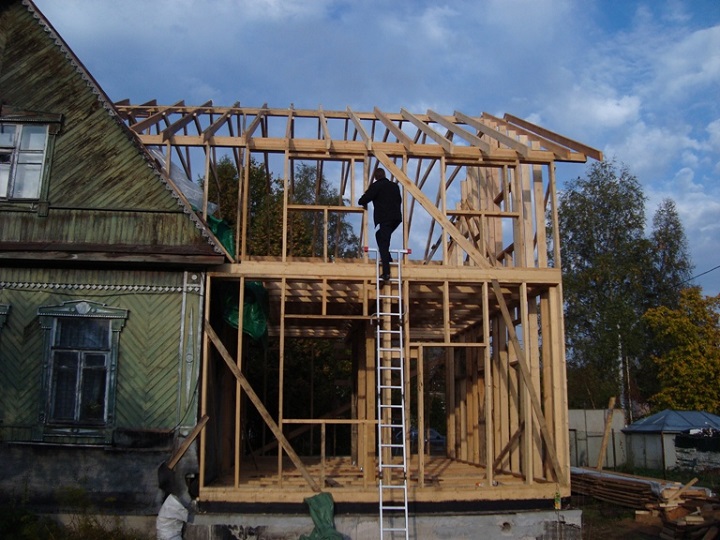In order to make the house comfortable, the best solution is to create an additional space. First of all, the projects of extensions to the wooden house and any other must be properly legally formalized.
It is better to do this in advance, because it is easier to make changes to them than to rework the already finished construction.
Objectives of building an extension
- Arrangement or porch.
- Creation of a technical room (workshop, garage, boiler room, electrical room, pantry).
- Expansion of living space (living room, bathroom, kitchen, dining room, hallway).
In this case, it is necessary to take into account that the annex has some peculiarities in comparison with other structures.
Which extensions are suitable for a wooden house?
Despite the functional difference of the additional premises, there is an obligatory condition - ensuring the safety of the main building. For wooden houses, the use of extensions of identical material is expedient for the sake of creating harmony and preventing overloading of the foundation. If the main building is a log house, logs, cant timber and even aerated concrete blocks are suitable for it. But the wooden extensions remain preferable.
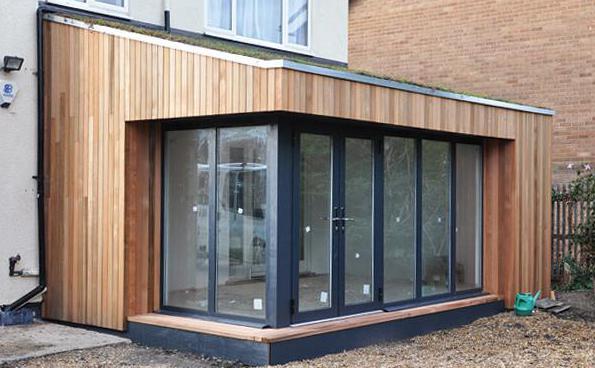
The most rational option is to attach the frame structure. Availability of modern materials for sale makes it possible to make new premises as comfortable and functional as possible all year round.
What should I consider when creating an extension?
In construction, the following factors should be provided:
- and its dimensions.
- The condition of the walls with the roof and what elements require replacement.
- The possibility of a rigid connection of structures and the creation of a transition between rooms.
- Transitions between rooms.
Due to the fact that the wooden extension shrinks during the first year after construction, its rigid attachment to the walls of the house is not recommended. Between them are left the so-called relative vertical slippage of walls. It is necessary even with a common foundation and divides all parts of the building from the bottom up, up to the roof. Finally, the seam is filled with elastic bands, expanded polystyrene, plastic mass from bitumen, silicone or acrylic.
When combining different materials at the connection point, the embedded elements are used: reinforcement, channel, corner. Tightness of the joint is created by means of a gap of 1-2 cm, which is then filled with a mounting foam and covered with a latch. Metal should be carefully painted to protect against corrosion.
It is quite realistic to create a basement under a new premise. In this case, a ribbon foundation is needed for deep deposition. But it is impossible to lay a new foundation below the base of the old one. The sole of the basement of the extension must be the same as that of the house, or be placed higher.
Project work
The most popular projects are additions to the wooden house due to economy, simplicity and efficiency. First of all, a project is being created. The extension complements the house, creating a single whole, and not a separate part of it. It is important to consider the condition of the contacting walls and, if necessary, replace the decayed parts.
One style should be followed. Dimensions of the additional structure should not exceed 2/3 of the house. In doing so, it is necessary to take into account that the general appearance of the facade is not disturbed. The area of the veranda is usually about 20% of the house.
The annexe can be two-storeyed. It is important to ensure its reliable thermal insulation. If the attached room is combined with the rooms of the house with doorways, it must be reliably insulated. Otherwise, it will affect the microclimate of the whole house. Protection from cold should be provided from all sides.
When you change a house, you need permission from the city's architectural committee. All necessary drawings are prepared. The price of the services of the construction company, which undertakes to create an extension project to a private house, is from 25,000 rubles. A suitable option can be selected according to the proposed photos. 
Typical ready-made projects are difficult to apply, because it is necessary to link to the existing design of the house and the state of the ground. They are taken as a basis, making changes of different levels of complexity, depending on the wishes of customers. As a result, an original solution can be obtained. 
The erection of a new foundation
When projects are being developed extensions to the wooden house, special attention is paid to the foundation. To prevent it from shrinking, it is connected to the base of the house. You can not get a monolith, but you can approach it. First, a trench is digging and the attached parts of the main foundation are released. From it, the waterproofing is scraped off, and then the notch with a diameter of at least 100 mm is drilled to a depth of 60-80 mm. After the crown instead of the crown, thin holes are drilled in the concrete. Then the reinforcement is clogged in them. The frame of a new foundation is attached to it and its concrete is poured. After hardening, waterproofing is laid on the base, after which it is possible to build an extension from any material, but it is not recommended to create heavy structures.
If the reinforcement of the two foundations is not done, they may disperse over time.
How to make a roof?
The roof of the extension is being erected in isolation. It is made of a single-pitched and with a great inclination. Connection to the main structure is not carried out. In this case, it is necessary to ensure a tight fit of the roof to the wall of the house. Then its subsidence will not occur in the process of shrinkage and shrinkage of the structure.
The roof is located below the main one or is made with it as one unit. It should be provided that the shrinkage of the new structure does not lead to subsidence of the roof. If the decision is made to build a roof common, then it is necessary to do a reconstruction of the whole roof.
Construction of an extension of the bar
Projects extensions to a wooden house often involve the manufacture of new structures from the same material, for example, from a bar. The building is usually attached to the wall of the facade and can have as many floors as their houses. Then the foundation is made the same, and the roof can be common or one-sided pitched. Under the veranda, a lightweight columnar base is used.
The walls are built using the same technology as for the main house. The beam joins together nagels. Fastening to the main wall is made by plates with screws or staples.
An extension of the bar is usually designed for living quarters. 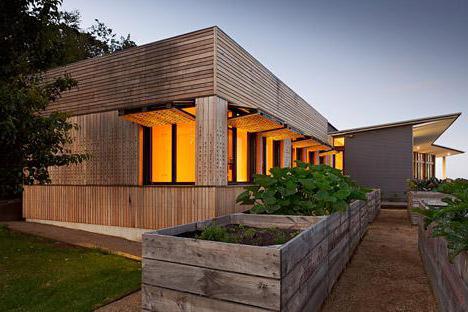
For it, the roof can be made common, by linking the overlapping to the metal corners. The design of the drainage system is done in one piece.
Expenses for the extension are as follows:
- type of construction and finishes;
- number of floors;
- complexity of the foundation;
- availability of communications;
- type of timber.
The overall list also includes the project cost, transportation and complexity of construction. 
Frame Attachment
The frame base is the simplest and most common solution for erecting an extension to a wooden house. Despite the fact that this technology has appeared recently, it has received universal recognition because of the economy and speed of construction. 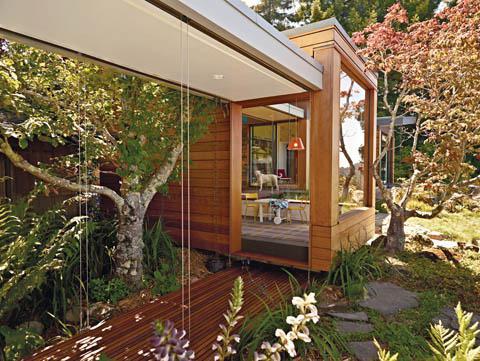
The frame is made of wood or metal. The cost of construction depends, first of all, on its purpose. The most expensive costs require the erection of a dwelling, where warmth is required with mineral wool, polystyrene foam, polyurethane foam and other heat-protective materials.
Metal structures are made of profiles of different shapes and sizes by welding. The cheaper wooden frame also features strength and durability.
The foundation is made small and can be shallow or columnar. It is displayed on a par with the main on the upper level.
The wooden frame is treated with an antiseptic and fire-fighting compound. Then it is assembled. From the side of the facade walls are covered with sheets of plywood or OSB, with a siding or plastic finish, and inside - with a lining. If it is pre-coated with several layers of varnish, the service life of the material will be considerably prolonged. Between the outer and inner lining is laid insulation.
The addition of the porch to the frame structure is not difficult. Under it is a small foundation, connected with the main one.
Conclusion
Addition to the house allows you to increase living space with minimal expenses and create comfortable living conditions. You can do it yourself, if you correctly develop your own or make changes to the finished projects with reference to specific conditions. In this case, you should not make mistakes in construction.
Attachment to the house is an excellent solution for expanding the free space in a suburban home of any type. It is important that all construction work can be performed independently.
Of course, this will require certain building skills and knowledge of the technology of work, but nothing particularly complicated in this. Help specialists may be required at the stage of designing the structure, as well as when supplying communications inside the structure. In addition, often there are certain problems when legalizing the extension in the regulatory bodies.
The annex can perform a variety of functions.
Most of the annexes are built to form an additional room, a summer kitchen, a garage, a veranda, a terrace, a canopy, a porch. There are a lot of options - everything will depend on personal requirements and wishes. Of course, something will build very difficult from a technological point of view, but often all construction is done by oneself.
The main thing here is to properly perform the erection of the foundation, walls, roofs, insulate and isolate the room from the effects of moisture, and also correctly connect the new base to the old one.
Types of extensions for country houses
Before starting any construction work, you need to clearly define the type of construction, because you can make an extension to the house only if you have a clear plan and project. We can distinguish several of the most common types of extensions in our country:
Canopy
This is the most simple in execution and less expensive from all points of view, extension for a country house. The main functional task of this design is to protect people and things under the canopy from sunlight, rain and other precipitation. Under such a canopy it will be good to have a rest in the warm season and have dinner, or you can put a car.
Carport for the car.
An important advantage of the canopy arrangement is that the foundation is not required, because the support pillars (made of metal, wood, concrete) will act as the base. To these supports the skeleton of a canopy is fixed.
Summer room
To form a summer room will require more capital construction than in the case of a canopy. Such premises are intended for rest in a warm season, gatherings, reading books, etc. Naturally, you need a foundation.
It is recommended to use a columnar or ribbon base, depending on the type of building material and the dimensions of the room. For the creation of walls, boards, foam concrete blocks, frame shields are usually used. For better lighting, the walls and roof, in whole or in part, can be made of glass.

Summer room.
Such an annex usually has a single-pitched roof or a double-skinned roof. Roofing material is recommended to use the lightest. Installation of heat insulation materials, as a rule, is not carried out, because such premises in the cold season are not operated.
Living room
Before you attach a room to your home, you must complete all the required calculations and draw up a project. In this case, a thorough approach will be required, including the foundation, the capital construction of walls and roofs, the installation of waterproofing and heat insulation materials, the supply of all necessary communications.
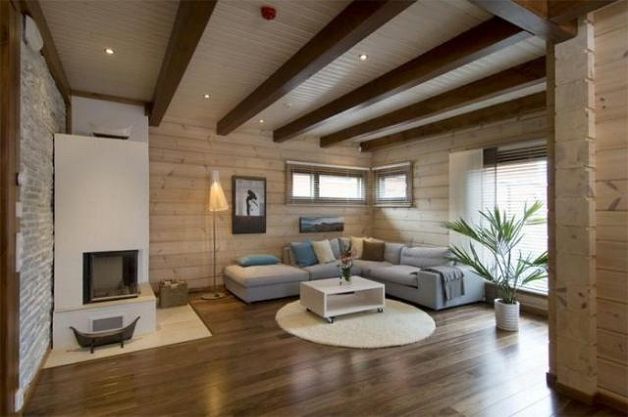
Warm living room.
Particular attention is paid to the insulation of the premises, that here one could live in winter, without spending much energy for heating.
Kitchen
As a rule, extensions are not designed for kitchen appliances. Such a construction must be capital, so it needs to maximize its efficiency.

The kitchen is made of wood.
It is possible to build such an extension only with the use of a quality project created by professionals, because the kitchen needs to provide all the communications: sewerage, water supply, electricity, gas, ventilation system. This, of course, leads to serious financial costs, to which not all are ready.
Garage
Using an extension for a garage device is a very common trend in recent years. For the garage will require the construction of a tape or monolithic foundation, and for the erection of walls usually used foam blocks or brick.
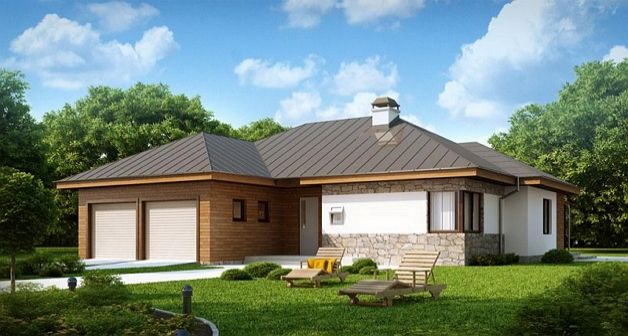
Two garages.
The roof, in most cases, is made of profiled sheet or metal, slate or roofing material. Required communications for the garage - ventilation system and heating.
Connection of outbuilding with a country house
Many people choose for a long time where to attach a new premise to their house, so that it would be easier to connect it to the main building. Choose here comes from two options:
- Independent building. In the event that complex ground conditions are observed in the terrain (for example, cloddy soils or a high level of groundwater), it is recommended to build an independent structure that will not be connected to the main house in any way. In this case, the extension and the main structure have no points of contact, so they do not depend on each other. At the same time, between the two buildings, the minimum possible distance is observed, which is a technological gap, which must be filled with heat-insulating and waterproofing materials.
- Adding an extension to the structure to the old building. Such a decision implies a certain amount of labor, because the construction will imply compliance with all necessary technologies and carrying out a variety of calculations and studies. First of all, it will be necessary to build and warm the foundation properly, which must be competently connected to the base of the country house. This is usually done with reinforced rods. Almost the same technology connects the walls and roof structures.
Features of roof construction for extension to the house
The roof of the extension to the house can have any shape - here again everything will depend on the requirements and wishes of the owners. Along with this, most often country house owners choose a single-deck roof, because it is simple in execution, it is easy to insulate on its own, it blends well with other types of roofs, which can have a basic structure, and also removes precipitation well, preventing the whole structure from experiencing additional load.
To rainfall from the roof of the extension drained in normal mode, the design of the roof implies the device of the roof slope of 20 degrees or more.
In addition, special attention should be given to building the roof of the annex to the roof of the country house. If everything is done correctly, the wall between the outhouse and the country house will be protected from water through the joint between the two structures. In addition, the roof of the extension should harmoniously combine with the roofing material of the main building and harmoniously fit into the exterior of the building, without standing out against the general background.
In the design process, it is very important to correctly calculate the load that the roof construction will give. It is necessary to take into account the weight of the rafters, roofing material and other structural elements used in the construction of the roof.
It is important to understand that an extension to the house on screw piles or poles is not designed for too serious loads, unlike a monolithic or ribbon concrete foundation. It is also necessary to insulate the roof (it is possible to insulate using any suitable heat-insulating materials, which it is recommended to cover with waterproofing from above).
How to legalize construction?
To build an extension to an old or new country house is half the battle. Any additional premises erected on the land plot must be documented and obtained permission to conduct construction work from the supervisory bodies.
Attachments to the house with their own hands can be done as you like - no one will force to invite builders, but a country house owner should present to the employees of the control services a well-designed building design.
The procedure for completing all documentation for an extension to an old country house usually takes from several months to a year.
An interesting point - to start collecting documents and obtaining permission for construction can be done after all the work is completed. This is permitted by applicable law.
At the same time, when reviewing documents, the employees of the supervisory authority may have some claims that will necessarily have to be corrected (for example, the location of the building with respect to underground utilities or the use of inappropriate building materials).
Consider buildings to the house and not an extension
Pergola - the simplest structure and a great place to relax.
The barbecue is a great place to receive guests and holidays.
In the village, are you happy? On the one hand - it is so modern and practical, especially in the summer. Do not look for a cheap recreation center, buy permits for a boarding house, send children to the camp. In your home you can live all summer, good, next to the railway. You can get to work in half an hour. But, what a beauty: fresh air and space, near the forest and river. Nature beckons to itself with its colors and freshness. But here's the problem, the house is old, though sturdy! It is good that the tree is not damaged by time, it is not beaten by termites. Only in small areas there are damage to logs that are not of a local nature.
Roof Removing
On the family council it was decided to carry out a cosmetic repair of the old wooden house with the replacement of some elements of the roof and floor, parts of the damaged logs under the windows or around the crown. The first thing you need to repair the roof, which has a leak in some places. For this, complete dismantling and replacement is not necessary. In places creating, put patches from the same or similar material. To install patches on the roof, two rolls of ruberoid and a decent piece of resin were needed. Assistants in such a case are needed in order to melt the resin, raise it and roll up. The leaky part is thoroughly cleaned of debris and poured with melted resin. The pitch is leveled and a piece of roofing material is spread on top. Recessed in the resin will dry up, not allowing leaks. The industry offers many modern roofing roll materials that adhere to the surface without resin, but by heating with a blowtorch or other heaters. They are slightly more expensive in price.
Replacement of parts of logs
When self-repairing an old wooden house, the damaged ones must be replaced. For this, rotted areas are sawed out, and at the ends of the crests are set. To them attach new pieces of logs of the same diameter as the old round logs. Under the new wood lay a layer of pakli. The new logs should be treated with special compounds. Such work will prevent the appearance of a new rot in the future. If cracks appear in the logs, they should be processed and sealed with special components. The ideal form of repair would be a complete change of damaged logs, but such an event is expensive and long-term. It is carried out when they are going to live in the building most of the time or constantly. A temporary holiday home can be repaired in a capital way, when there are no material problems.
Extension to the house repair old wooden house scheme repair old house reinforcement foundation
Cosmetic repair of an old wooden house
Internal redecoration of the old wooden house is for your pleasure. It's nice to come from a city apartment to a clean room, not oversaturated with expensive furniture and exclusive decor items. In this case, you can use simple paper wallpaper or colored plaster. The wooden floor, which has no rotten areas, can only be painted. In case of the appearance of rotten areas, the damaged places are changed. From above lay linoleum or a covering from DVP. From unnecessary furniture items should get rid of. The freshness of the repair and not cluttered space is the criterion of a comfortable home.
How to make an annex to the house?
Over time, the total area of the house becomes insufficient for a family in which children grow up, and then grandchildren. In this case, many owners are ready to make an extension of an open type to the house, called a terrace, or a closed type - a veranda. In order to make an extension of any type to the house, a foundation will be needed. It will not be necessary only if an open area is planned in front of the house, which has four brick or concrete columns erected, serving as a support for a non-severe cover without doors. In this case, you can build a beautiful arch. And then, under the supports, you need to make four small foundations. In order for the verandah to be friendly with the main walls, it is necessary to shrink the foundation of the extension. Good owners pour the foundation in late spring or summer, but only after a year, the next summer, begin to erect walls. During this time, the ground should be compacted in the area of the future veranda. One can not allow a new attached building to begin to sink, involuntarily moving, relative to the main building. Succumbing to such a complex deformation, cracks or detachments from the walls can appear in unpredictable places. The most experienced specialist can not tell how to make an extension to the house on an unstable foundation. In this case, additional soil tamping and light weight overlap and roofing material can help. The extension is constructed from various materials, among which the most popular and acceptable are:
- wooden frame structures;
- log constructions;
- brick;
- , block.
In the annexes, huge frames are used, as on the balcony, with a height of 0.5-0.6 meters from the floor, even lower than the window sills in the rooms. Due to the peculiar alternation of the deaf and opening windows, their dimensions, a special design of the annex building is created. The roof of the veranda, usually one-sided and sloping. The best material for the roof is an identical material with a house covering or a lighter one - roll, steel, asbestos-cement, aluminum.
Purpose of the annexe
Attachment to the main room is made of materials that are identical to or different from the main building. In each individual case, an annex is executed, depending on what type of premises the owners wish to see and how warm it should be. Most often on the veranda organize a place for gatherings and eating. Sometimes it serves as a summer kitchen. Along with this, the veranda can become an additional bedroom, especially in the warm season.
Without preliminary receipt of permits, an extension to the house with their own hands is an illegal increase in the area of housing. It can not legitimize the fact, if violates the interests of neighbors, built from materials that do not meet the standards SNIP, it is close to underground utilities. The optimal solution is to design before starting work with a preliminary design by specialists.
According to the current legislation, an extension to the house with their own hands is any residential, functional premise, a loggia or a balcony. Any room (from a winter garden to an extra bedroom) falls under this definition. Obligatory elements of the annex are: Unlike the main building, there may be no overlapping, the roof can have several design solutions: Door, window openings in the main walls of the dwelling, if necessary, are manufactured using a special technology: At the design stage it is important to choose a rational combination of functionality, the exterior of new facades. The new premises should not impede access to communications passing through the site. Various designs increase snow retention, additional loads from snow bags should be taken into account in the strength calculations of the elements. With an increase in the working area of the building in use, horizontally horizontal slabs, ribbon foundations of deep occurrence are economically unprofitable. The optimal options are the following types of construction: In all these ways, an extension to the house with their own hands will be cheaper. When choosing a columnar, pile foundation, it is necessary to additionally protect the lower part of the structure, which does not have contact with the surface, from freezing. For this fit ground siding with an inner layer of insulation (basalt wool or extruded polystyrene) fixed by analogy with ventilated facade crates cells. Before making an extension to the house, you should rationally select the material of the walls. In wireframe, panel technology, this is usually a sandwich: More expensive way is laying of lightened blocks (foam, aerated concrete). When choosing foam concrete blocks an ordinary builder, who usually does not have the practice of construction work, special education, one should take into account the peculiarities of this material: This is due to the structure of the foam concrete, the cracks are not through, do not reduce the strength characteristics. In addition, foam, aerated concrete weakly hold the embedded parts, fasteners, therefore, the Mauerlatt requires careful fixation in the following ways: The walls of foamed concrete have insufficient strength for heavy roofing materials (shale, ceramic, cement-sand tiles). It is better to cover the building with flexible or metallic tiles, onduline, profiled sheeting. Before making an extension to the house, you should carefully design, calculate the configuration, strength of the truss elements, choose the right step when placing them on the Mauerlate. With the same height of the walls of the farm, they can rely on existing power structures. Rafters of low outbuildings to two-story cottages are recommended to rely on the columns located near the existing walls.

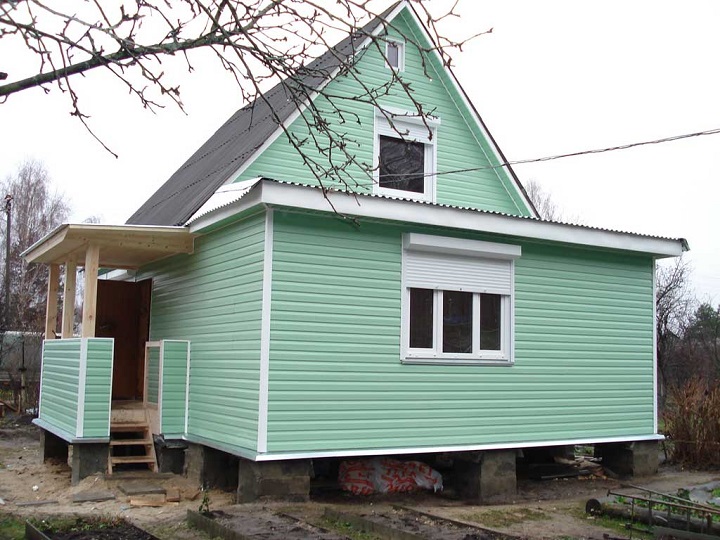

Making the foundation of the extension



From what material do the walls of the annex?
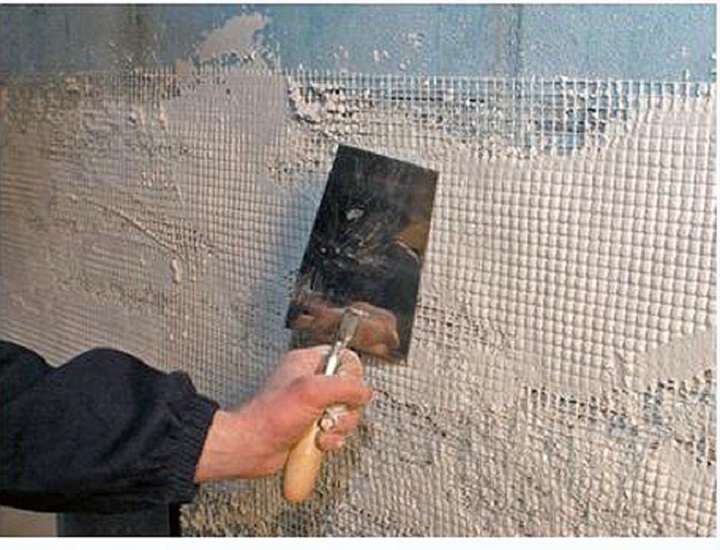
Changing the rafter system
Having your own private home, sooner or later, there is a desire to slightly expand it. Superstructure of the second floor is quite expensive and time-consuming. But to attach to the house one more living room, in principle, is another way to improve living conditions.
With what to begin and how to make an extension to the house, let's understand. Attachment to the holiday home is constructed quite simply, so consider adding an additional room to the existing apartment building.
In contact with
Before you start the construction of an extension of the living room to an individual residential building, you need to get permission from the architecture and town planning department of your city.
Learn more about how to do it to prevent mistakes when building bricks on your own.
Insulation of the roof from the inside is not very expensive and will save money on heating the house. On how to perform insulation and what materials to choose, read.
To do this, you will need to provide documents for the land plot (lease agreement or certificate of ownership, cadastral passport), documents for the house (certificate of ownership, technical passport), construction and architectural projects (in principle, the project can be one, but in It must necessarily have sections that affect the construction and architectural part of the constructed annex) and, of course, write an appropriate application for permission.
After receiving permission, we proceed to construction. Of course, it is necessary to begin construction with the construction of a foundation. To do this, along the perimeter of the future annex, by digging a ditch at least half a meter in depth, the width of the ditch should be approximately the same.
The bottom of the ditch is covered with sand and gravel. This is necessary in order to increase the density of the foundation connection to the ground, and also in order to reduce the risk of subsidence of the foundation.
After we begin to fill the foundation. The solution of the future foundation is prepared based on the climatic conditions of your region, the features of the soil of the earth, the size of the future room and the weight load on the foundation that is provided to it (all this should be reflected in the design). In addition, the foundation must be below the freezing level of the soil.
If the foundation is higher than this level, then in this case the moisture accumulated in the ground will freeze and expand during freezing, and thereby cause additional uneven loads on it. Such an impact on the foundation will lead to its deformation, so that on it and the walls of the future room may appear cracks of various sizes.
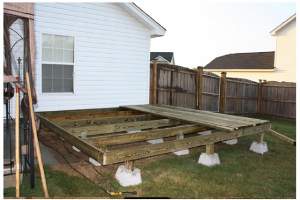 After the foundation is filled, it should be watered abundantly. Begin to water should be in eight to ten hours after the completion of works on its erection. This is necessary to avoid the appearance of cracks on it and its uneven drying. This procedure should be performed three to four days in a row.
After the foundation is filled, it should be watered abundantly. Begin to water should be in eight to ten hours after the completion of works on its erection. This is necessary to avoid the appearance of cracks on it and its uneven drying. This procedure should be performed three to four days in a row.
In order to constantly not run with a hose, the foundation can be evenly covered with wet sawdust. Completely the foundation will dry after three to four weeks. But this does not mean that you can immediately begin to erect walls. Let it stand for a year. During this time, the foundation will completely settle and "find" its place.
When pouring a foundation, it is better to give preference to the type of its construction, which will be similar to the construction of the foundation under the main house. If the foundation under the main house protrudes outside its borders, a new foundation can be "tied" to it, to give strength and avoid additional subsidence.
Walling
The walls of the room can be erected from bricks, cinder blocks or from round logs, or other suitable building material. Attachment of the blocks to the house is also quite a viable option, although not the best. Here everything will depend on your preferences and financial possibilities.
But it is better, from the point of view of aesthetics, the material of the walls of the new annex should be similar to the material of the walls of the main house or be combined with it (unless, of course, you are going to carry out exterior decoration of the walls of the entire house with modern finishing materials). An example can serve as a frame extension to a wooden house, this is simply done and looks aesthetically.
The height of the walls (ceiling) of the new extension should be just below the height of the main building. It should be lower exactly as much as it will be required to arrange the roof.
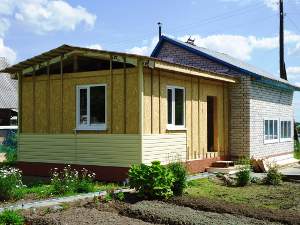 When building the walls of a new room, you need to solve the problem of their "connection" with the wall of the main house. In this case, experts do not recommend a hard connection. Since the weight and "age" of the main structure exceeds the analogous parameters of the new annex, which in turn affects their uneven subsidence. A rigid connection in this case will cause the appearance of cracks. And not only at the junction. It is best to use an "elastic layer" in such cases.
When building the walls of a new room, you need to solve the problem of their "connection" with the wall of the main house. In this case, experts do not recommend a hard connection. Since the weight and "age" of the main structure exceeds the analogous parameters of the new annex, which in turn affects their uneven subsidence. A rigid connection in this case will cause the appearance of cracks. And not only at the junction. It is best to use an "elastic layer" in such cases.
"Elastic interlayer" is settled as follows. The wall of the extension should not be adjacent to the wall of the main building. Between them you need to leave a small distance of two to three centimeters. The space left is filled with a special sealant (Vilaterm or foamed polyurethane) for expansion joints and gaps.
Making the roof
It has already been said that the height of the annex should be just below the main house. So, when constructing the roof of a new room, you need to ensure that the roof goes under the curtain overhang at home, forming a smooth transition. The conjugation of the two roofs should be such as to maximally prevent the rainfall or rain or other moisture from getting into the extension.
Best of all, at the junction of the roofs, the transition is arranged from a galvanized iron corner. One part of this corner is brought in centimeters to thirty or forty under the roof of the main building and the same amount is left on the roof of the new extension. The resulting space between the roof and the edge of the metal corner is carefully sealed.
Beams for the roof of a new room can be made, for example, from wooden beams. The bars themselves are laid on pre-prepared grooves in the wall. As a roof covering extension add a similar material to the roof of the main structure. The ceiling must be insulated. As a heater can be used expanded clay or mineral wool, or a similar material. The ceiling itself can be either wooden or reinforced concrete slab. The same goes for sex.
By the way for floor leveling it is best to resort to a dry screed. By its qualities, such a screed does not differ from others. In addition, it requires less labor and financial costs.
The interior of the new room will depend on its purpose and your design abilities. But before that, do not forget first to spend in the new room all the necessary networks of engineering and technical support, for example, electricity and heat supply.
And in the end I would like to say that all construction work on erecting an outbuilding to a residential building must be carried out in strict accordance with the project submitted to the Department of Architecture and Urban Development.
Any deviation from the project will entail certain legal consequences, up to the impossibility of legalizing the house as a whole. If at the construction stage of the annex you are diverted for some reason from the project, then it is better to immediately inform the department of architecture and town planning, get their approval and make the appropriate changes to the project.
After the extension of the new living room will be erected and adopted by the commission for commissioning of buildings and structures, you can safely go to the registration chamber and make changes in the title documents to the house.


